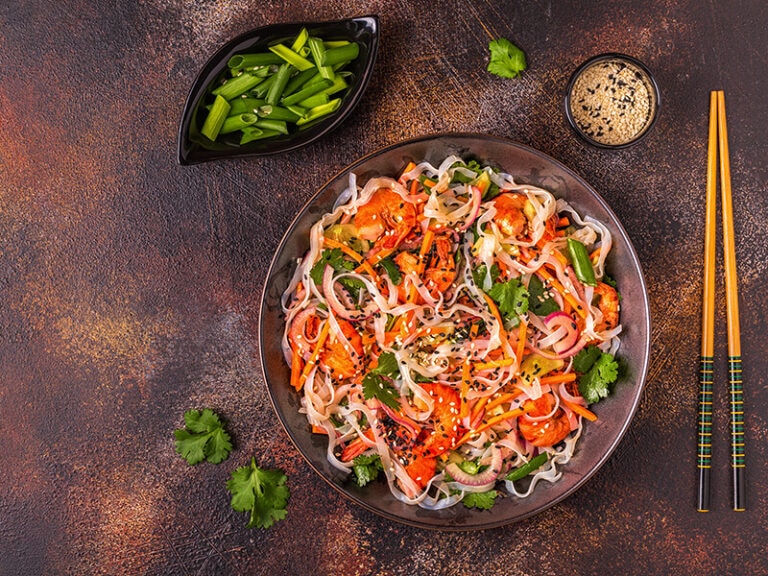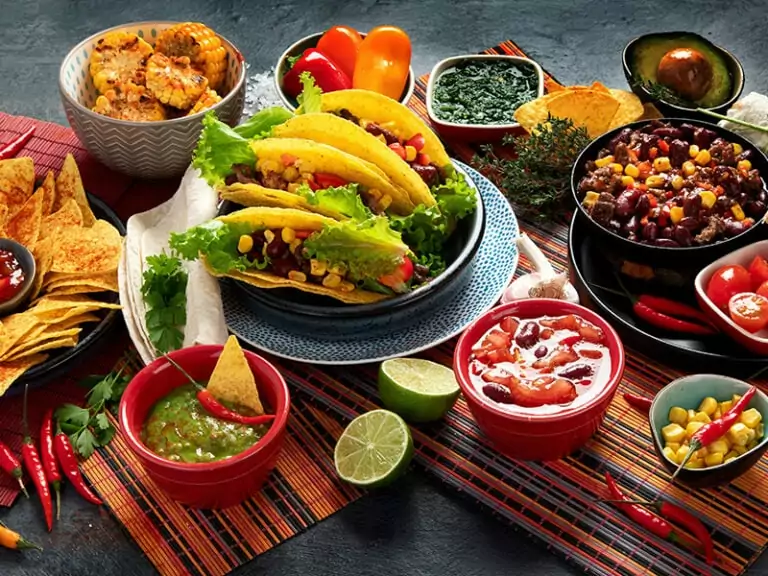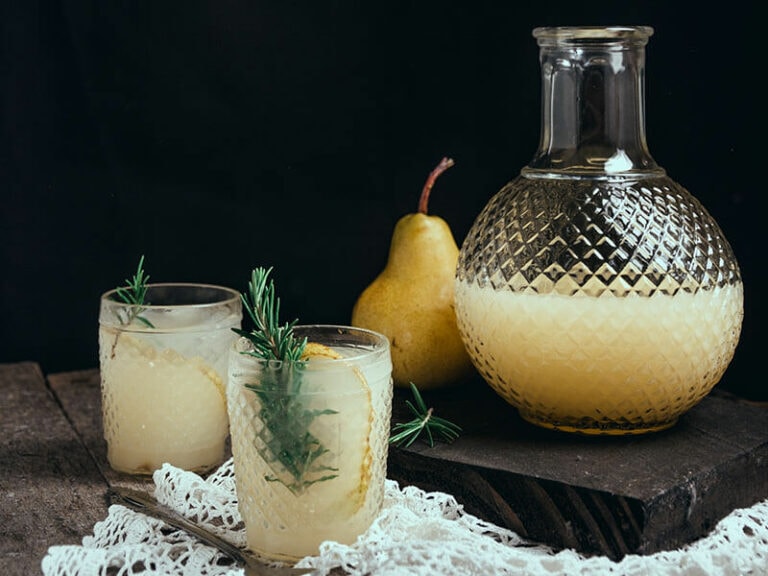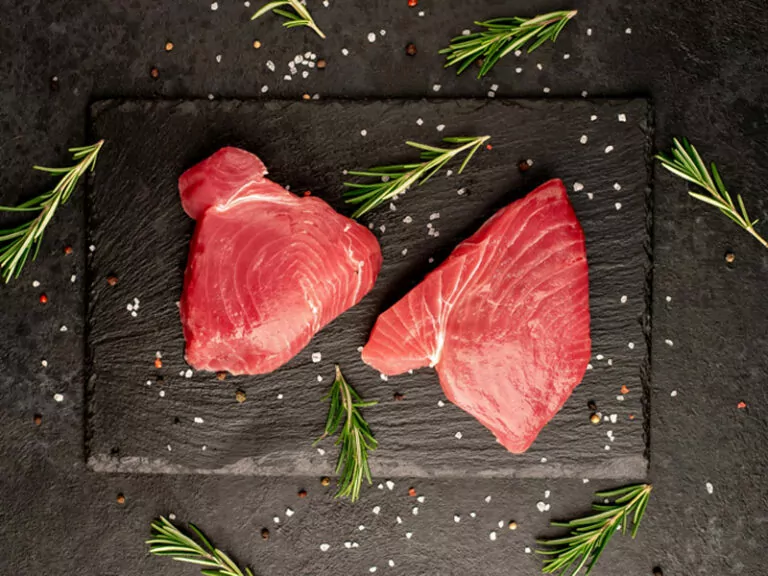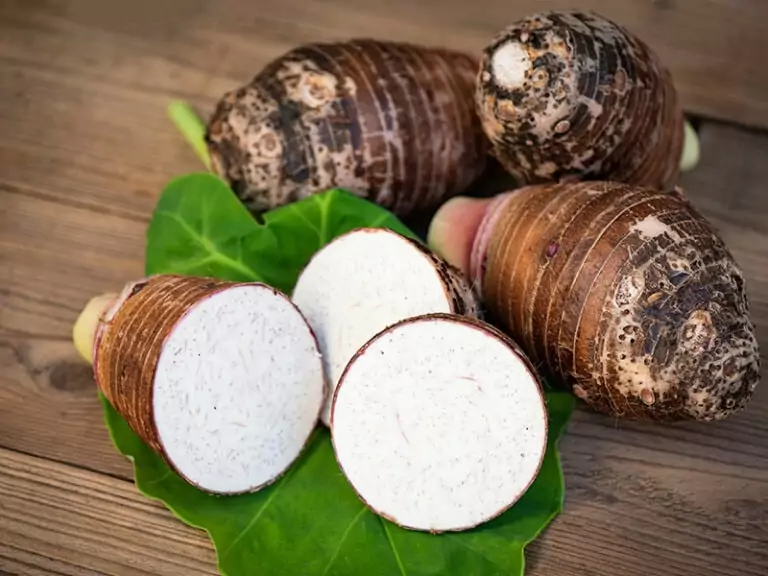How long do stainless steel pans last? Many people may find the question strange. Most people never think of the day they have to replace their cookware, let alone if the item is made of high-quality material like stainless steel.
Some cookware lasts longer than others, with better material and ideal storage conditions. However, most of them should be replaced after a period (especially if they’re heavily used). Let’s discover when you should replace your stainless steel pans and how to keep them last longer.
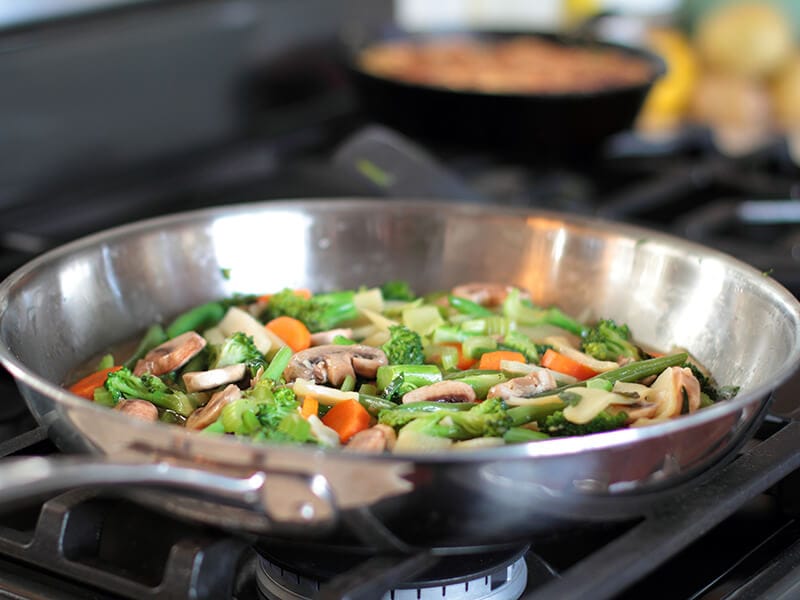
Some Background About Stainless Steel
Stainless steel is arguably one of the most popular materials for manufacturing cookware. It’s an all-rounded material that performs well in many aspects of cooking.
What Is Stainless Steel?
Stainless steel is an iron alloy resistant to oxidizing agents, so it’s unlikely to rust and corrode.
Its resistant nature is attributed to the 11% chromium and other components such as carbon, nonmetals, and metals. These components form a passive film that preserves the whole structure and self-heals when exposed to oxygen.(1)
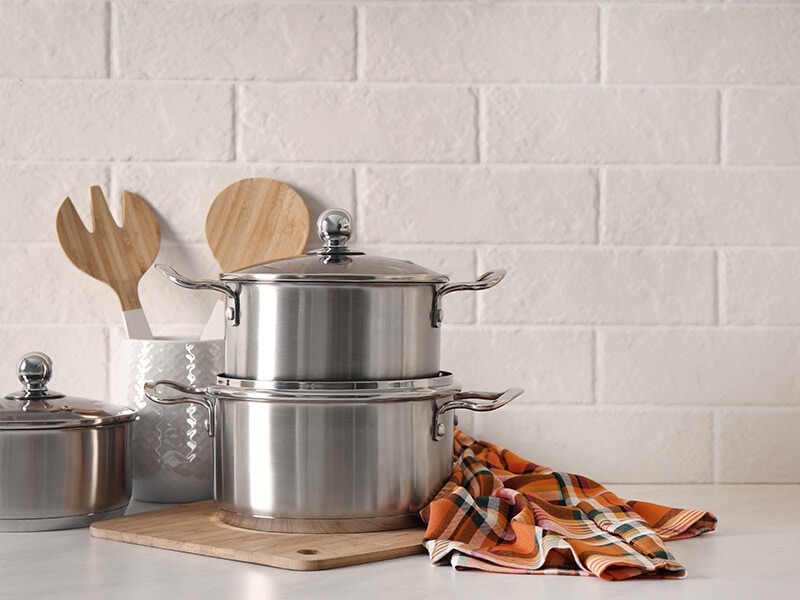
Advantages Of Stainless Steel Cookware
Stainless steel has many properties that make it ideal for making cookware. Here are some remarkable features of this material:
Durability And Robust
The stainless steel structure makes it super durable to cope with impact and corrosion. It is not prone to scratches and dents. It won’t rust, flake, chip, or stain, either.
Stainless steel outperforms many other materials like non-stick or aluminum regarding durability. Some brands are so confident about the material’s durability that they offer a lifetime guarantee for their stainless steel products.
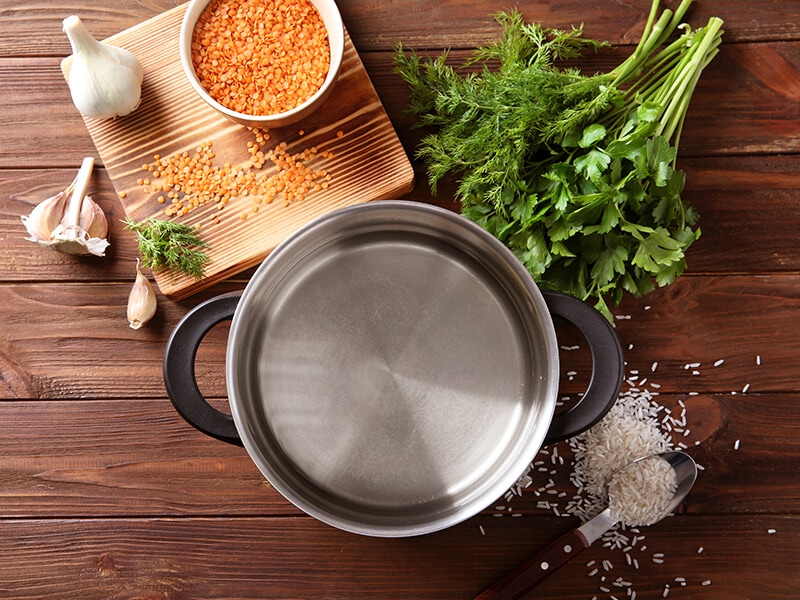
Heat Distribution
Most stainless steel cookware has aluminum or copper core inside, so they heat incredibly quickly and evenly. This reduces cooking time and results in more desired results.
Stainless steel with a copper core is the best since its heat conductivity is even better than aluminum, resulting in more consistent cooking.
Furthermore, it is great for all-purpose cooking. It performs well in virtually any cooking method, such as searing, sauteing, cooking soup, stewing, braising, and more. This is all thanks to its high heat conductivity and even distribution.
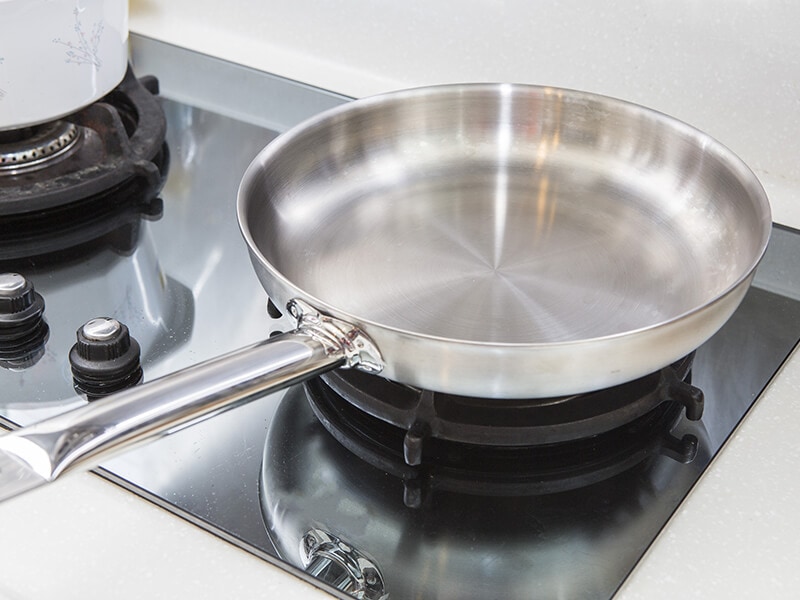
Responsiveness
Unlike ceramic or iron-clad, stainless steel doesn’t retain much heat and is quickly responsive to temperature change, enabling you to control your cooking easier.
All you have to do is turn the stove/oven up or down to adjust the temperature of your cookware. This will save you from burning your food, especially with spices like onion or garlic, which are prone to become overcooked and stick to the bottom.
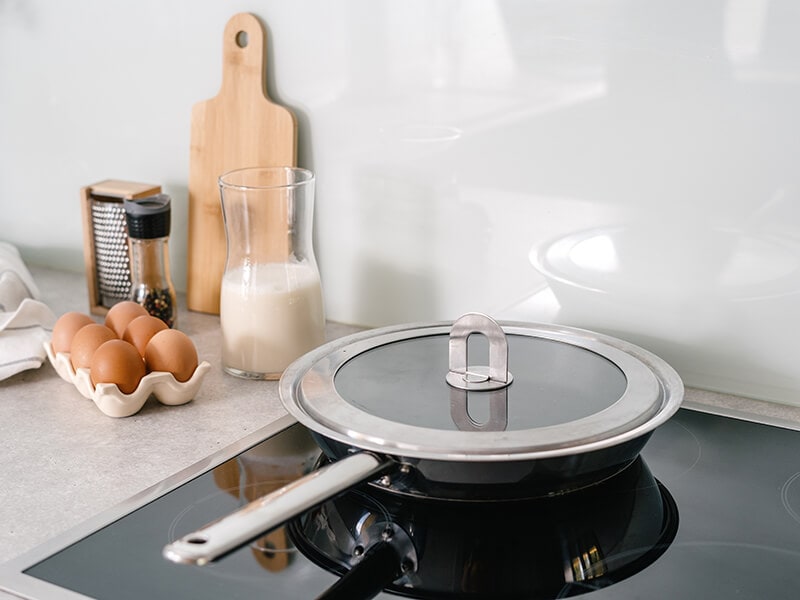
High Heat Resistance
Stainless steel can handle high heat with ease. Whether you cook with an oven or stove, your stainless steel cookware will accomplish the job unscratched. Especially when cooking steak, this method requires high heat to get the meat well done outside and rare inside.
Transferring meals from stove to oven has never been easier with stainless steel. You don’t need to worry about them getting warped or ruined in high temperatures.
Here are the main advantages of stainless steel cookware.
How Long Do Your Stainless Steel Pans Last?
The answer depends on many factors. There is no exact number when it comes to determining the lifespan of cookware. If you pay attention to handling and storage, stainless steel pans will last many decades (some can last up to 50 years).
These pans don’t have a non-stick coat or cast iron season that is prone to peeling off. Therefore, you’re cooking on bare steel when cooking with stainless steel pans.
However, cheap materials and carelessness in cooking, cleaning, and storing are the factors that can reduce the longevity of your stainless steel pans to one to three years.
In most cases, stainless steel needs replacement due to warping, rusting, and denting, making the pans less non-stick. Even though most manufacturers offer a lifetime warranty on their products, they won’t cover damage caused by customers.
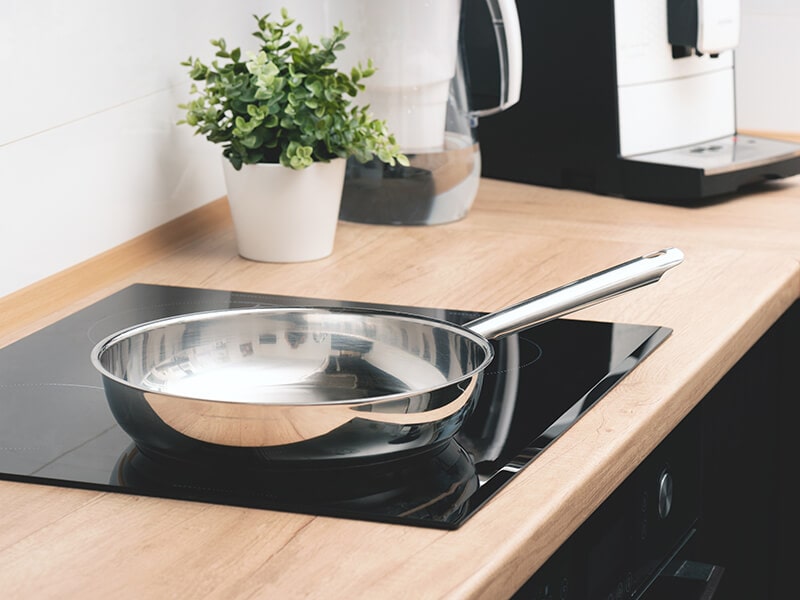
Factors That Affect The Lifespan Of Your Stainless Steel Pans
Several factors dictate the longevity of your pans. However, steel grade, cookware construction, design, and brand reputation are the most important ones:
Steel Grade
Not all stainless steel cookware is the same. There are multiple steel grades for you to choose from, ranging from 18/0 stainless steel (the lowest grade) to 18/8 (middle grade) and 18/10 (the highest grade).
You can easily find the kind of steel used in each brand in the specification on the retailer’s website. Those numbers are the proportion between chromium and nickel, respectively, which are responsible for the resistance to rusting and corrosion of the material.
The higher the ratio, the more robust and resistant the steel is. In 18/0 steel, there is 0% nickel in the compound, making it less durable than its 18/8 and 18/10 counterparts. The lack of nickel makes it magnetic and usable in induction stoves.
18/8 steel is a cheaper variant compared to 18/10 steel. It is inferior to 18/10 steel in terms of heat conduction. However, you should remember that it’s just a 2% difference, but there is a large cost gap between these two kinds of steel.
18/10 steel is unparalleled in retaining a high polish finish and keeping rust off the surface. It’s a better choice in terms of quality.
On a side note, nickel can be released into the food, causing potential health problems. Scientists are urging the stainless steel cookware industry to consider switching to a non-nickel formulation for less harmful.(2)
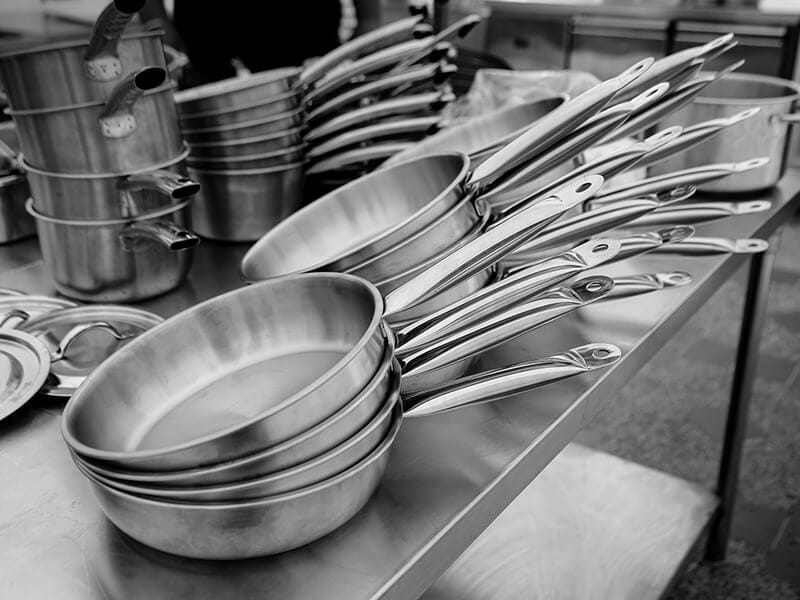
Thickness Of The Pan
Pans with thick walls tend to be more durable and resistant to warping. Most basic thick-walled pans come with 2.3mm walls, but some models can have thicker walls of up to 2.7mm. But remember that thickness also means heavier weight.
Pan Design
Design is a vital factor that dictates the longevity of your pans. That’s why large cookware makers invest a large sum of money into developing new designs and models. For example, pans with sealed rims last longer and are less prone to corrosion than exposed rims.
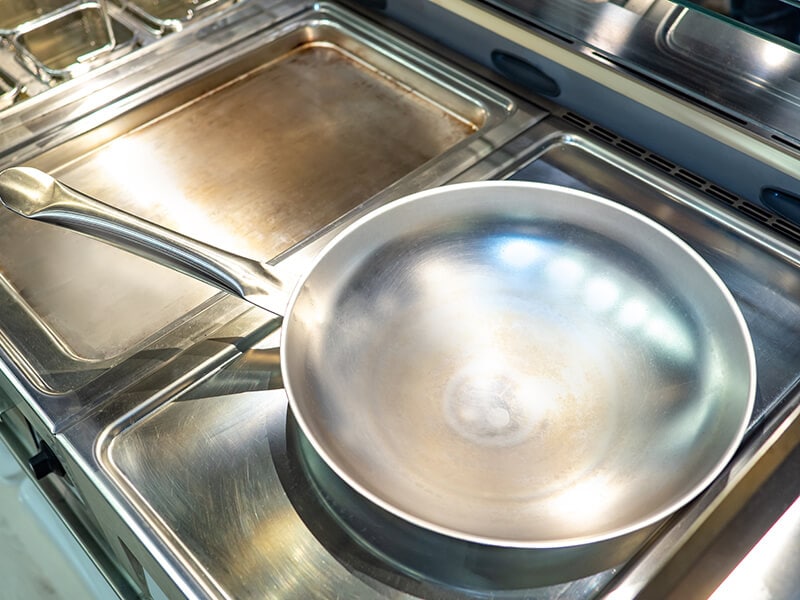
Cookware Construction
Stainless steel pans come in 2 types with different characteristics: fully-clad and impact-bonded.
Stainless steel is not a great heat conductor, yet this is not a big issue as people have applied the cladding technique in making stainless steel. Cladding is to integrate multiple layers of materials to get the best out of each.
A fully-clad pan consists of many bonded layers of steel and a copper or aluminum core for maximum heat conduction. The number of bonded layers is called ply.
For example, 3-ply means 3 layers bonded, and 5-ply is 5 layers. Sometimes each ply comes in different materials. Although impact-bonded is the same technique, it is only used in making the base to produce a multi-layered bottom, while the sides are just one thin layer of steel.
Generally, fully-clad stainless steel pans have a longer life span and are more resistant to damage than impact-bonded types. However, they are also heavier and pricier.
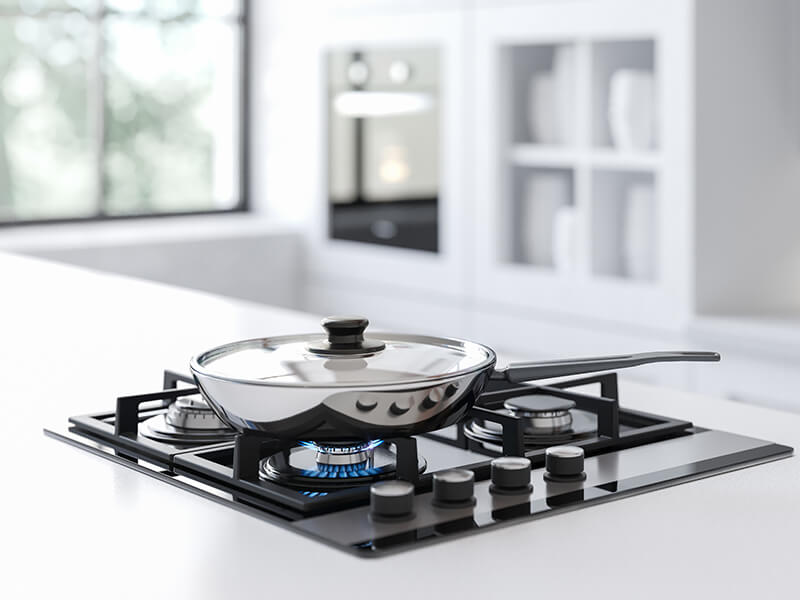
Trusted Brands
Reliable companies build their reputation from the quality of their products. If you don’t know where to start, buy your cookware from a highly-rated brand.
The most famous and trustworthy brands like All-clad, Cuisinart, Tramontina, or OXO are the suppliers that can offer the best products. Never settle for less when it comes to buying cookware for your kitchen.
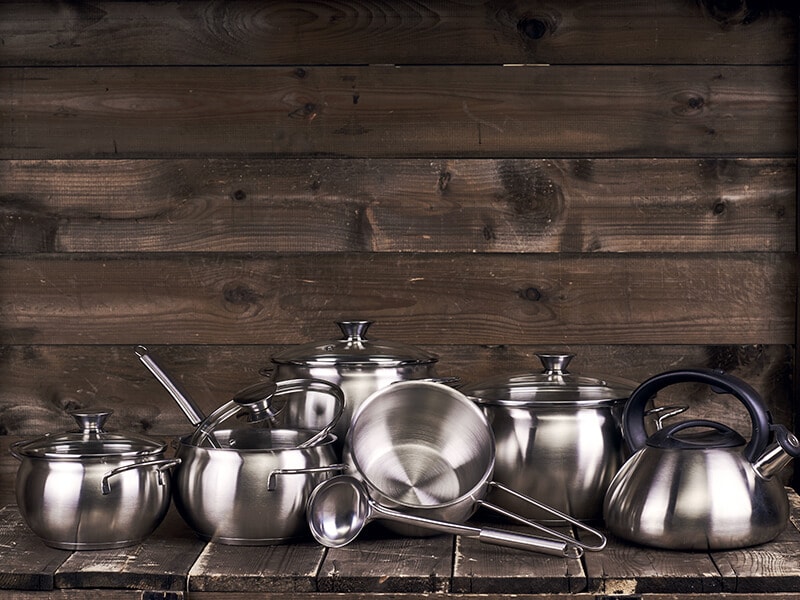
How To Extend The Life Of Your Stainless Steel Pans
Taking good care of stainless steel cookware is not rocket science after all since it’s very durable and resistant to damage. There are just a few tips that you should be mindful of when handling your stainless steel pans.
Play By The Rules
The rules here are manufacturer’s manuals. They have the best experts in the field, and they know what’s best for their products. Read the instructions on cleaning and maintenance to know what you should do.
Store In The Right Space
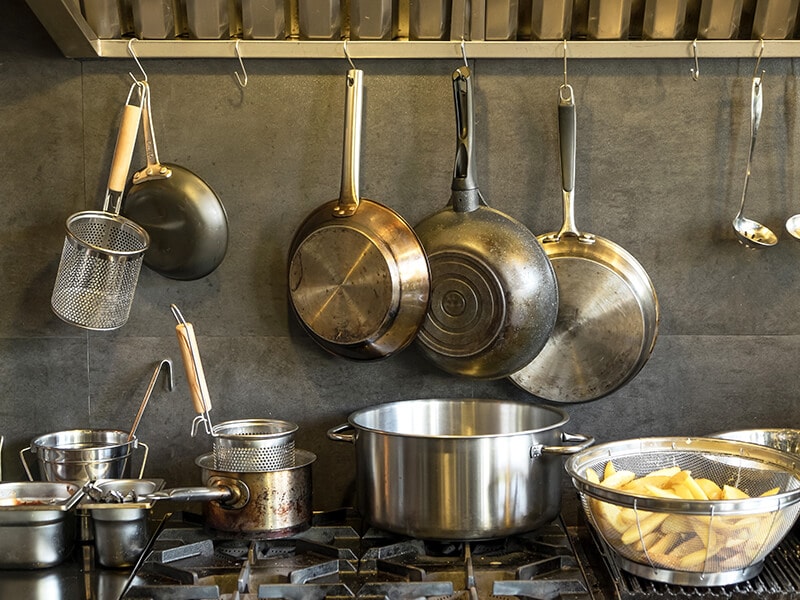
Never stack your metal cookware directly on each other since it can cause scratches, dents, and even peeling of the non-stick layer from some cookware. You can place soft materials like cardboard, paper towel, or pot holder in between when storing them.
It’s better to store your pans in an open space to air dry them. If not possible, dry your pans with a kitchen cloth to remove all excess water before storing them. Water spots and rust are the results of poor storage conditions.
Keep Your Pans Clean
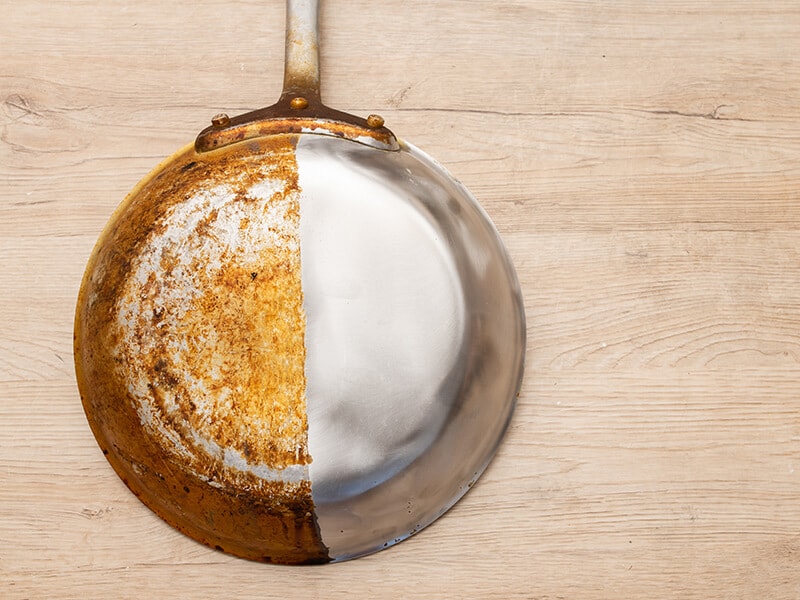
Never allow food residues, burn marks, burnt oil, food stains, and watermarks to stick to the cooking surface of your pans. To easily remove them, boil vinegar water in the pans, then add two spoons of baking soda to break down hard-stuck particles.
They will be long gone after wiping with a soft cloth. For burn marks outside the pans, mix baking soda with a little water, rub some paste on the marks and rinse with water.
Did you know how to clean your stainless steel pan properly? Follow these easy steps.
Avoid Using Metal Utensils And Metal Pads
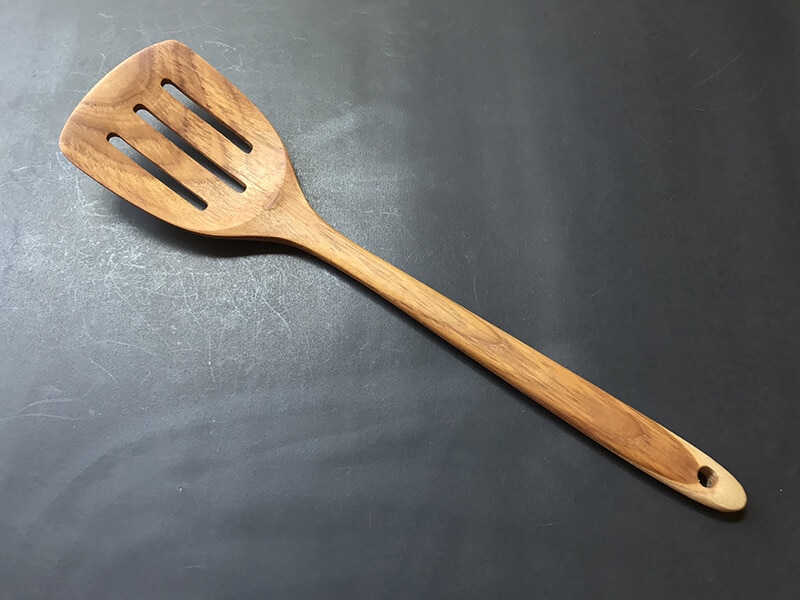
As durable as stainless steel pans, they are not immune to impact, especially from rough materials. If you apply metal utensils with great force for a long period on their surface, they will have scratches and dents in no time.
To prevent further regrets, switch to more steel-friendly options such as wooden, silicone, glass, and ceramic. Also, never cut your food directly on the pan surface with a knife; that’s a sure way to give your pan a scratch.
Opt for non-abrasive tools like plastic scouring pads or soft sponges to wipe the surface when cleaning.
With hard-stuck food residues, submerge the pans in warm detergent to loosen off the stains first. In cases when stainless steel pads are the only option, remember to scrub along the lines of your pan.
Control The Heat
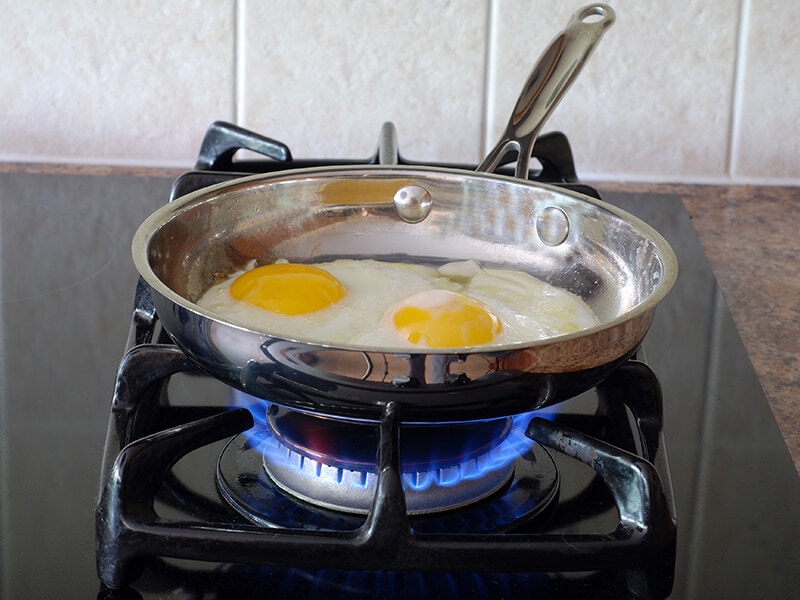
There are several rules when applying heat to your stainless steel pans. Here are some points you should keep in mind:
- Never let the temperature exceed the manufacturer’s limit: Don’t try to test your stainless steel by getting it out of its comfort zone. There is a maximum safe temperature that you can find in the product description.
- Heat your pan before adding oil: As the pan heats up, the surface expands, and oil won’t get caught between the microscopic lines on the surface, which leads to burning.
You can put some teaspoons of water in a heated pan. If the water forms one or two beads, it’s safe to add oil.
- Don’t leave an empty pan sitting on the heat for too long. Doing so can lead to burning and discoloration of the pan. Heat tint with a rainbow pattern might appear, and it’s very difficult to get rid of.
Heating your pan correctly can help extend its lifespan.
Avoid Alkaline Or Non-Chlorinated Cleaning Detergents
The layer of chromium oxide of the stainless steel is what makes it resistant to corrosion and self-heal damage. Harsh detergents like strong alkaline or chlorine bleach can damage that protective layer beyond repair. Use warm water and mild detergent to clean the pans.
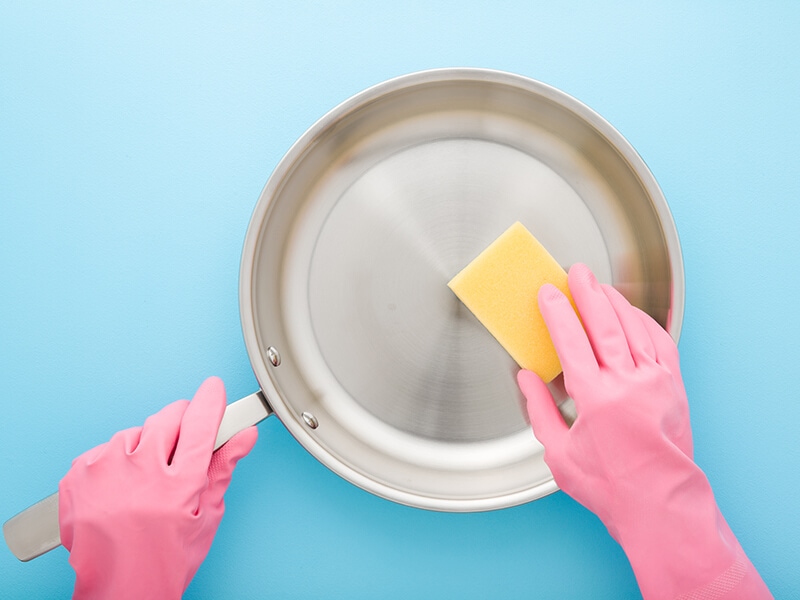
Avoid Washing Your Stainless Steel Pans In Dishwasher
Don’t bet on that dishwasher-safe feature in the advertisement. The high and strong detergents in the dishwasher can severely damage your pans over time. I recommend you hand wash your stainless pain with a soft cloth and milder detergents.
Signs That Tell You To Replace Your Stainless Steel Pans
Nothing lasts forever, including stainless steel. Sometimes stainless steel pans are not safe to use anymore and must be replaced. Look for these signs to know whether your old cookware should retire.
Scorched, Rusted, Or Discolored Bottom
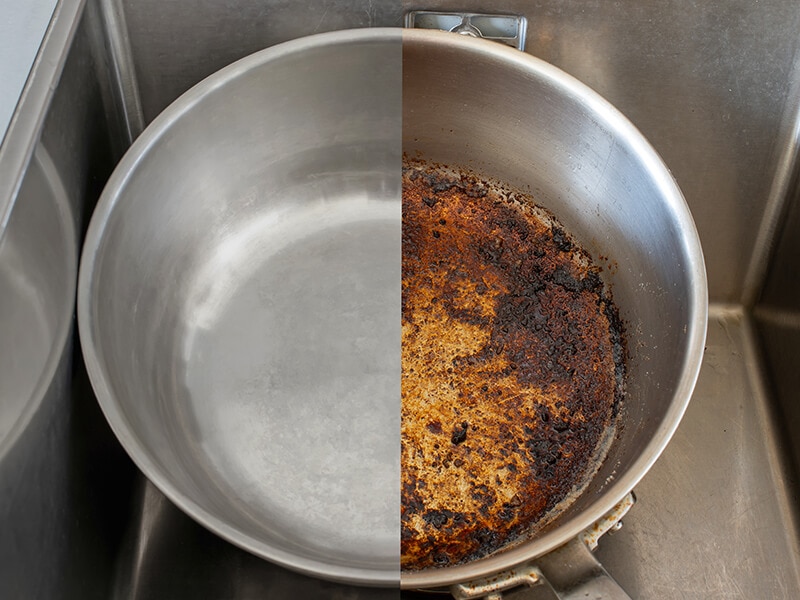
If you have tried your best but still can’t get rid of the rusty, scorched, and discolored spots, it’s time to replace your stainless steel pans. Don’t compromise the food quality since it can cause potential health issues.
See how to prevent your stainless steel frying pans from sticking.
Issues With Handles
If you find the handles loosened, rusty, or fallen out, it’s time to replace your stainless steel pans. The damage or rust on the handles indicates that your pans might be too old.
Even though you can also try tightening the handles with a screwdriver, never think glues will work. Glues might give you a false sense of tightness, yet they can fall off anytime, causing burn hazards. You can try warranty repair if you think it’s the product’s fault.
Warping, Chipping, And Scratching Marks
Any sign of deformation in the interior of your pans is the ultimate reason to replace your pans. Chipping and scratching marks mean that tiny bits of metal can go into your food and might lead to health issues in the long run.
In this case, the protective layer already suffered damage, and its non-stick and non-reactive traits weakened considerably.
Also, if your pans can’t sit on the flat cooktop, it’s due to the warpings. Warped pans don’t heat evenly and can be dangerous as they will not sit properly and surface. That will lead to spilling or knocking over when cooking or serving.
These are structural damages and are very hard or impossible to repair. They mean it’s high time to replace your stainless steel pans.
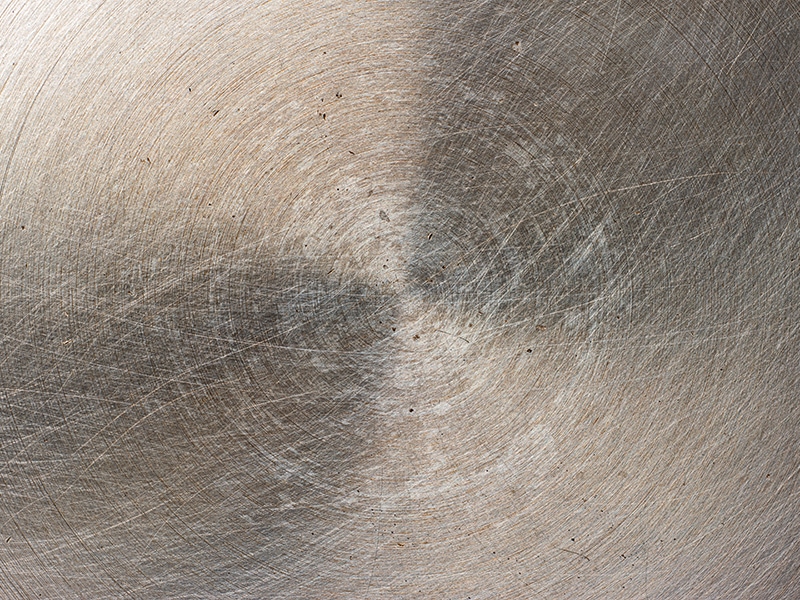
Serious Damages In Bonded Layers
There are some cases where you see your fully-clad pans with their layers separated and exposing the core inside.
If things like this happen, you should replace your pans immediately. The broken area may cut your hand. Plus, it is prone to go rusty and contaminate your food.
FAQs
Now you know when to replace your stainless steel pans and how to handle them properly. There is still more you can learn from these useful queries.
Always Take Good Care Of Your Stainless Steel Pans
Stainless steel pans are a staple in many kitchens. Due to its versatility, durability, and safety in cooking, stainless steel cookware has become the favorite choice of many chefs and home cooks.
This is not to say stainless steel pans are not indestructible. You should always be careful when handling them to keep them last longer.
Before leaving, please leave a comment about your favorite stainless steel products. Also, like and share this article on your social platforms if you find it useful for other cooks.
References
- Stainless Steel (2022) Wikipedia. Wikimedia Foundation.
- KM; K.J.H. (no date) Stainless steel cookware as a significant source of nickel, chromium, and iron, Archives of environmental contamination and toxicology. U.S. National Library of Medicine.

